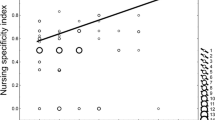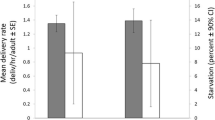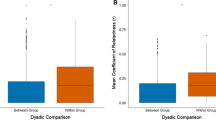Abstract
Lactation imposes substantial physiological costs on mothers and should therefore not be directed towards foreign offspring. Such allonursing, however, is common in mammal species that share roosts. Hypotheses to explain allonursing among such plural breeders include misdirected parental care, milk evacuation, brood parasitism, reciprocity, and kin selection. The necessary behavioral data, in combination with data on kinship and kin recognition, have rarely been available to distinguish among these explanations, however. In this study, we provide evidence for cooperative nursing and adoption by plural-breeding females in a nocturnal primate, the gray mouse lemur (Microcebus murinus), in which females forage solitarily during the night, but form day-time sleeping groups with one to two other females. We observed 34 resident females in an 8 ha study area in Kirindy Forest, Madagascar, over three consecutive annual breeding seasons and determined genetic relationships among all members of this population. Five sleeping groups of adult females were filmed inside their roosts during one breeding season after females gave birth. The composition of groups changed substantially across years, but they always consisted of close maternal relatives. All females within a group gave birth to one to three infants. They regularly transferred only their own offspring among roosting sites, demonstrating an ability to discriminate between their own and other’s offspring, but they regularly groomed and nursed related offspring other than their own and adopted related dependent young after their mother’s death. Kin selection may therefore be the main selective force behind cooperative breeding among these closely related females with a high mortality risk, providing each of them with family insurance.


Similar content being viewed by others
References
Andrès M, Solignac M, Perret M (2003) Mating system in mouse lemurs: theories and facts, using analysis of paternity. Folia Primatol 74:355–366
Bearder SK (1987) Lorises, bushbabies, and tarsiers: diverse societies in solitary foragers. In: Smuts BB, Cheney DL, Seyfarth RM, Wrangham RW, Struhsaker TT (eds) Primate societies. University of Chicago Press, Chicago, pp 11–24
Bearder SK (1999) Physical and social diversity among nocturnal primates: a new view based on long term research. Primates 40:267–282
Braune P, Schmidt S, Zimmermann E (2005) Spacing and group coordination in a nocturnal primate, the golden brown mouse lemur (Microcebus ravelobensis): the role of olfactory and acoustic signals. Behav Ecol Sociobiol 58:587–596
Charles-Dominique P (1977) Ecology and behaviour of nocturnal primates. Columbia University Press, New York
Clutton-Brock TH (1991) The evolution of parental care. Princeton University Press, Princeton
Clutton-Brock TH (2002) Breeding together: kin selection and mutualism in cooperative vertebrates. Science 296:69–72
Clutton-Brock TH, Albon SD, Guiness FE (1989) Fitness costs of gestation and lactation in wild mammals. Nature 337:260–262
Eberle M, Kappeler PM (2002) Mouse lemurs in space and time: a test of the socioecological model. Behav Ecol Sociobiol 51:131–139
Eberle M, Kappeler PM (2004a) Selected polyandry: female choice and inter-sexual conflict in a small nocturnal solitary primate (Microcebus murinus). Behav Ecol Sociobiol 27:91–100
Eberle M, Kappeler PM (2004b) Sex in the dark: determinants and consequences of mixed male mating tactics in Microcebus murinus, a small solitary nocturnal primate. Behav Ecol Sociobiol 27:77–90
Emlen ST (1982) The evolution of helping. I. An ecological constraints model. Am Nat 119:29–39
Emlen ST (1995) An evolutionary theory of the family. Proc Natl Acad Sci USA 92:8092–8099
Field J, Shreeves G, Sumner S, Casiraghi M (2000) Insurance-based advantage to helpers in a tropical hoverwasp. Nature 404:869–871
Getz LL, Gutermuth DF, Benson SM (1992) Pattern of nest occupancy of the prairie vole, Microtus ochrogaster, in different habitats. Am Midl Nat 128:197–202
Gibson S, Williams L, McDaniel M, Brazzel J, Abee C (1993) Allo-maternal lactation and nursing in squirrel monkeys (Saimiri boliviensis boliviensis). Am J Primatol 30:314
Goodman SM, O’Connor S, Langrand O (1993) A review of predation on lemurs: implications for the evolution of social behavior in small, nocturnal primates. In: Kappeler PM, Ganzhorn JU (eds) Lemur social systems and their ecological basis. Plenum Press, New York, pp 51–66
Griffin AS, West SA (2002) Kin selection: fact and fiction. TREE 17:15–21
Hamilton WD (1964) The genetical evolution of social behavior. J Theor Biol 7:1–52
Hapke A, Eberle M, Zischler H (2003) Isolation of new microsatellite markers and application in four species of mouse lemurs (Microcebus sp.). Mol Ecol Notes 3:205–208
Hayes LD (2000) To nest communally or not to nest communally: a review of rodent communal nesting and nursing. Anim Behav 59:677–688
Heinsohn R, Legge S (1999) The cost of helping. TREE 14:53–57
Kappeler PM (2000) Ecologie des microcèbes. Primatologie 3:145–171
Koenig WD, Dickinson JL (2004) Ecology and evolution of cooperative breeding in birds. Cambridge University Press, Cambridge
Kokko H, Johnstone RA, Clutton-Brock TH (2001) The evolution of cooperative breeding during group augmentation. Proc R Soc Lond B 268:187–196
König B (1993) Maternal investment of communally nursing female house mice (Mus musculus domesticus). Behav Processes 30:61–74
König B (1997) Cooperative care of young in mammals. Naturwiss 84:95–104
König B, Riester J, Markl H (1988) Maternal care in house mice (Mus musculus): II. The energy cost of lactation as a function of litter size. J Zool (London) 216:196–210
Lewis SE, Pusey AE (1997) Factors influencing the occurrence of communal care in plural breeding mammals. In: Solomon NG, French JA (eds) Communal breeding in mammals. Cambridge University Press, Cambridge, pp 335–363
Lunn NJ, Paetkau D, Calvert W, Atkinson S, Taylor M, Strobeck C (2000) Cub adoption by polar bears (Ursus maritimus): determining relatedness with microsatellite markers. J Zool (London) 251:23–30
Lyon BE, Eadie JMA (2000) Family matters: kin selection and the evolution of conspecific brood parasitism. Proc Natl Acad Sci 97:12942–12944
Marshall TC, Slate J, Kruuk LEB, Pemperton JM (1998) Statistical confidence for likelihood-based paternity inference in natural populations. Mol Ecol 7:639–655
Nakagawa S, Waas JR (2004) ‘O sibling, where art thou?’—a review of avian sibling recognition with respect to the mammalian literature. Biol Rev 79:101–119
Packer C, Lewis S, Pusey A (1992) A comparative analysis of non-offspring nursing. Anim Behav 43:265–281
Paetkau D, Strobeck C (1994) Microsatellite analysis of genetic variation in black bear populations. Mol Ecol 3:489–495
Pagès-Feuillade E (1988) Modalites de l’occupation de l’espace et relations interindividuelles chez un prosimien nocturne malgache (Microcebus murinus). Folia Primatol 50:204–220
Pen I, Weissing FJ (2000) Towards a unified theory of cooperative breeding: the role of ecology and life history re-examined. Proc R Soc Lond B 267:2411–2418
Perret M (1992) Environmental and social determinants of sexual function in the male lesser mouse lemur (Microcebus murinus). Folia Primatol 59:1–25
Radespiel U, Cepok S, Zietemann V, Zimmermann E (1998) Sex-specific usage patterns of sleeping sites in gray mouse lemurs (Microcebus murinus) in northwestern Madagascar. Am J Primatol 46:77–84
Radespiel U, Dal Secco V, Drögemüller C, Braune P, Labes E, Zimmermann E (2002) Sexual selection, multiple mating and paternity in grey mouse lemurs, Microcebus murinus. Anim Behav 63:259–268
Radespiel U, Lutermann H, Schmelting B, Bruford MW, Zimmermann E (2003) Patterns and dynamics of sex-biased dispersal in a nocturnal primate, the grey mouse lemur, Microcebus murinus. Anim Behav 65:709–719
Rasoloarison RM, Rasolonandrasana BPN, Ganzhorn JU, Goodman SM (1995) Predation on vertebrates in the Kirindy forest, Western Madagascar. Ecotropica 1:59–65
Rensing S (1999) Immobilization and anesthesia of nonhuman primates. Primate Rep 55:33–38
Roulin A (2002) Why do lactating females nurse alien offspring? A review of hypotheses and empirical evidence. Anim Behav 63:201–208
Roulin A, Hager R (2003) Indiscriminate nursing in communal breeders: a role for genomic imprinting. Ecol Lett 6:165–166
Schmid J (1998) Tree holes used for resting by gray mouse lemurs (Microcebus murinus) in Madagascar: insulation capacities and energetic consequences. Int J Primatol 19:797–809
Silk JB (2002) Kin selection in primate groups. Int J Primatol 23:849–976
Solomon NG, French JA (1997) Cooperative breeding in mammals. Cambridge University Press, Cambridge
Stanford CB (1992) Costs and benefits of allomothering in wild capped langurs (Presbytis pileata). Behav Ecol Sociobiol 30:29–34
Taberlet P, Luikart G (1999) Non-invasive genetic sampling and individual identification. Biol J Linn Soc 68:41–55
Thierry B, Anderson JR (1986) Adoption in anthropoid primates. Int J Primatol 7:191–216
West SA, Pen I, Griffin AS (2002) Cooperation and competition between relatives. Science 296:72–75
Wimmer B (2000) Untersuchung der Paarungssysteme und Populationsstruktur von Lemuren an Coquerel’s Zwergmaki (Mirza coquereli), dem grauen Mauslemur (Microcebus murinus), dem Rotstirnmaki (Eulemur fulvus rufus) und dem Larvensifaka (Propithecus verreauxi verreauxi). Ph.D. thesis, Universität München
Acknowledgements
We thank the late Prof. Berthe Rakotosamimanana (Département de Paléontologie et d’Anthropologie Biologique de l’Université d’Antananarivo), Prof. Olga Ramilijaona and Dr. Daniel Rakotondravony (Département de Biologie Animale, Université d’Antananarivo), Dr. Lucien Rakotozafy (Parc Botanique et Zoologique Tsimbazaza Antananarivo), the Commission Tripartite and the CAFF of the Direction des Eaux et Forêts, the CFPF Morondava, Prof. Jörg U. Ganzhorn, Prof. Hans Zischler, and Andreas Hapke for their authorization or support of this study. Thanks to Tiana Andrianjanahary for assistance in the field, and to Joanna Setchell and anonymous reviewers for helpful comments on an earlier version of the manuscript. This work was financially supported by the Deutsches Primatenzentrum (DPZ) and the Deutsche Forschungsgemeinschaft (DFG, Ka 1082/5-1, 2).
Author information
Authors and Affiliations
Corresponding author
Additional information
Communicated by J. Setchell
Rights and permissions
About this article
Cite this article
Eberle, M., Kappeler, P.M. Family insurance: kin selection and cooperative breeding in a solitary primate (Microcebus murinus). Behav Ecol Sociobiol 60, 582–588 (2006). https://doi.org/10.1007/s00265-006-0203-3
Received:
Revised:
Accepted:
Published:
Issue Date:
DOI: https://doi.org/10.1007/s00265-006-0203-3




